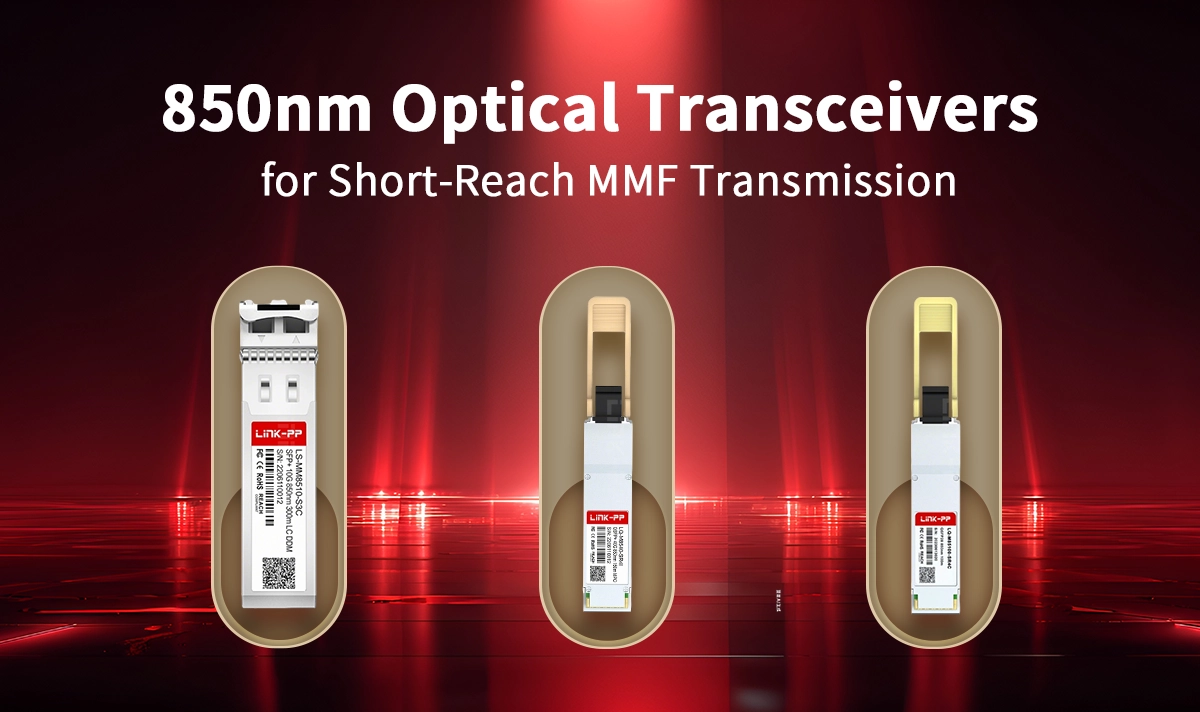
1. Introduction
In modern data centers and enterprise networks, short-reach connections account for the majority of optical links. For these scenarios, 850nm optical transceivers combined with multimode fiber (MMF) have become the most cost-effective and widely adopted solution. Leveraging VCSEL (Vertical-Cavity Surface-Emitting Laser) technology, 850nm modules offer low power consumption, high compatibility, and strong performance for distances up to several hundred meters.
2. Why Choose the 850nm Wavelength?
Industry Standard: IEEE 802.3 standards such as 10GBASE-SR, 40GBASE-SR4, 100GBASE-SR4, and 400GBASE-SR8 are all defined at the 850nm wavelength.
VCSEL Technology: 850nm modules rely on VCSEL lasers, which are inexpensive to manufacture, energy-efficient, and widely used in high-volume production.
Perfect Match with MMF: Optimized for OM3, OM4, and OM5 multimode fibers, 850nm modules ensure reliable short-reach transmission at 10G, 40G, 100G, and even 400G data rates.
3. Typical Types and Applications of 850nm Modules
SFP / SFP+ SR Modules
Data rate: 1G/10G
Transmission distance: up to 300m (OM3) or 400–550m (OM4)
Typical applications: enterprise LANs, campus networks
QSFP+ SR4 and QSFP28 SR4 Modules
Data rate: 40G (4x10G) / 100G (4x25G)
Transmission distance: 100m (OM3) / 150m (OM4)
Typical applications: rack-to-rack and aggregation layer connections in data centers
400G QSFP-DD SR8 Modules
Data rate: 400G (8x50G)
Transmission distance: 70–100m (OM3/OM4)
Typical applications: next-generation hyperscale data centers
4. Matching 850nm Modules with Multimode Fiber
Fiber Type | 10G SFP+ SR | 40G/100G SR4 | 400G SR8 |
|---|---|---|---|
OM3 | ≤ 300m | ≤ 100m | ≤ 70m |
OM4 | ≤ 400–550m | ≤ 150m | ≤ 100m |
OM5 | Optimized for 850–950nm | Supports higher parallel transmission | Emerging deployment |
OM3: Cost-effective option for shorter links.
OM4: Extended reach up to 550m at 10G, widely deployed in data centers.
OM5: Newer wideband multimode fiber designed for higher-speed SR4/SR8 modules.
5. Advantages and Limitations of 850nm Modules
✅ Advantages
Lower cost compared to 1310nm single-mode modules
Low power consumption and compact design
Mature manufacturing process and high interoperability
❌ Limitations
Maximum reach typically ≤ 550m
Distance decreases at higher speeds (e.g., 100G/400G)
Not suitable for long-haul or metro networks (>2km)
6. LINK-PP 850nm Optical Transceiver Solutions

LINK-PP offers a full portfolio of 850nm short-reach optical modules, designed for data centers, enterprise networks, and storage environments:
10G SFP+ SR Transceivers – Up to 300–550m on OM3/OM4
40G QSFP+ SR4 Transceivers – Up to 100–150m on OM3/OM4
100G QSFP28 SR4 Transceivers – High-performance parallel transmission for up to 150m
400G QSFP-DD SR8 Transceivers – Next-generation short-reach solutions for hyperscale networks
👉 All LINK-PP transceivers are fully compliant with IEEE 802.3 standards, support low power consumption, and are tested for multi-vendor compatibility.
📌 Explore LINK-PP Optical Transceiver Products
7. Conclusion
The 850nm wavelength remains the most reliable and cost-effective choice for short-reach multimode fiber connections. With strong support from VCSEL technology and widespread compatibility with OM3/OM4/OM5 fibers, 850nm optical transceivers continue to dominate data center interconnects. Looking ahead, SR modules at 100G, 400G, and beyond will ensure 850nm technology maintains a critical role in high-speed networking.
8. Frequently Asked Questions (FAQ)
Q1: What is the maximum transmission distance of an 850nm transceiver?
A: Typically up to 550m on OM4 fiber at 10G, and around 100–150m at 40G/100G.
Q2: Why are 850nm transceivers cheaper than 1310nm modules?
A: They use VCSEL lasers, which are cost-effective, energy-efficient, and easy to manufacture.
Q3: Where are 850nm modules most commonly used?
A: Data center rack-to-rack connections, enterprise LANs, and storage networks.




